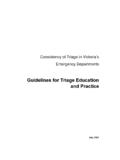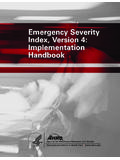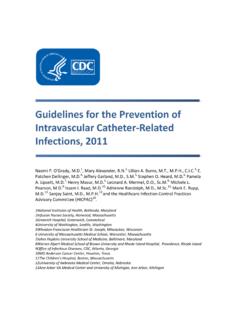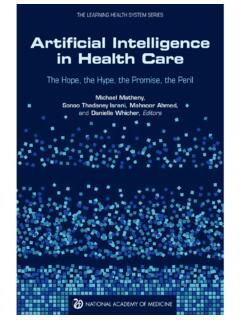Transcription of Emergency Severity Index, Version 4: Implementation Handbook
1 Advancing Excellence in Health Care for Healthcare Research and QualityEmergency SeverityIndex, Version 4:ImplementationHandbookEmergency SeverityIndex, Version 4:ImplementationHandbookCopyright noticeThe Emergency Severity Index Version 4 Triage Algorithm (the Algorithm ) is the intellectual property ofThe ESI Triage Research Team, LLC (the Author ). The Author has applied for copyright with the UnitedStates Copyright Office. The Algorithm is the sole and exclusive property of the Author, and the Agencyfor Healthcare Research and Quality has a license to use and disseminate the two works derived from thisalgorithm: the training two-DVD set ( Emergency Severity Index Version 4: Everything You Need toKnow ) and the Implementation Handbook ( Emergency Severity Index Version 4: ImplementationHandbook ). The Author hereby assures physicians and nurses that use of the Algorithm as explained inthese two works by health care professionals or physicians and nurses in their practices is permitted.
2 Eachprofessional user of these two works is granted a royalty-free, non-exclusive, non-transferable license to usethe Algorithm in accordance with the guidance in these two Algorithm may not be changed in any way by any user. The algorithm and the contents of the DVDset and Implementation Handbook may be incorporated into additional training materials developed by auser, on the condition that no fee is charged by the user for the Algorithm, the contents of these twoworks, or the additional training Algorithm has been rigorously tested and found to be both reliable and valid, as described in theresearch references included in these two works. However, the Author and the Agency for HealthcareResearch and Quality require that the Implementation and use of the Algorithm be conducted andcompleted in accordance with the contents of these two works using the professional judgement ofauthorized physicians or nurses and staff directed and supervised by them.
3 Each health care professionalwho decides to use this algorithm for Emergency triage purposes does so on the basis of that health careprovider's professional judgment with respect to the particular pateint that the provider is caring for. TheAuthor and the Agency for Healthcare Research and Quality disclaim any and all liability for adverseconsequences or for damages that may arise out of or be related to the professional use of the Algorithmby others, including, but not limited to, indirect, special, incidental, exemplary, or consequential damages,as further set forth Author and the Agency for Healthcare Research and Quality have made a good faith effort to take allreasonable measures to make these two works accurate, up-to-date, and free of material errors in accordwith clinical standards accepted at the time of publication. Users of these two works are encouraged touse the contents for improvement of the delivery of Emergency health care.
4 Any practice described inthese two works should be applied by health care practitioners in accordance with professional judgmentand standards of care used in regard to the unique circumstances that may apply in each situation theyencounter. The Author and the Agency for Healthcare Research and Quality cannot be responsible for anyadverse consequences arising from the independent application by individual professionals of thematerials in these two works to particular circumstances encountered in their To Obtain Additional Copies of the DVDs and HandbookAdditional copies of the Emergency Severity Index, Version 4: Everything You Need To KnowDVD set(publication no. 05-0046-DVD) and spiral-bound Implementation Handbook (publication no. 05-0046-2),covering all the details of ESI, can be obtained by contacting the AHRQ Publications Clearinghouse at 1-800-358-9295 or by e-mail to You may request up to 3 free copies of both the DVDset and the Implementation Handbook .
5 You can also view, download, and print a PDF Version of the manualonline at To Obtain Additional InformationFor additional information on the Emergency Severity Index, Version 4, please e-mail your substantivequestions to Severity Index, Version 4: Implementation Handbooku u uNicki Gilboy, RN, MS, CENN urse Educator, Emergency DepartmentBrigham and Women's HospitalBoston, MAPaula Tanabe, PhD, RN Research Assistant Professor Northwestern University Department of Emergency Medicine and the Institute for Health Care Studies Chicago, ILDebbie A. Travers, PhD, RN, CENR esearch Assistant Professor University of North CarolinaChapel Hill, NCAlexander M. Rosenau, DODepartmental Associate Vice ChairProgram Director of the Emergency Medicine ResidencyDepartment of Emergency MedicineThe Lehigh Valley Hospital and Health NetworkAllentown, PADavid R.
6 Eitel, MD, MBAD irector, Health Services DesignCore Faculty, Emergency Medicine ResidencyDepartment of Emergency MedicineThe York HospitalWellSpan Health SystemYork, PAu u uThis Handbook is dedicated to our leader,collaborator, and friend,Dr. Richard WuerzAt the time of his death Dr. Wuerz was an Attending PhysicianAssociate Research DirectorDepartment of Emergency MedicineBrigham and Women's HospitalBoston, MAandAssistant Professor of Medicine ( Emergency Medicine)Harvard Medical SchoolBoston, MAiiSuggested Citation:Gilboy N, Tanabe P, Travers DA, Rosenau AM, Eitel DR. Emergency SeverityIndex, Version 4: Implementation Handbook . AHRQ Publication No. 05-0046-2. Rockville, MD: Agencyfor Healthcare Research and Quality. May from the DirectorThe Agency for Healthcare Research and Quality is pleased to bring you the Emergency SeverityIndex, Version 4: Implementation manual covers all details of the EmergencySeverity Index (ESI) a five-level Emergency department triage algorithm that providesclinically relevant stratification of patients into five groups from 1 (most urgent) to 5 (leasturgent) on the basis of acuity and resource needs.
7 After Emergency physicians Richard Wuerz and David Eitel developed the ESI in 1998 andpilot testing yielded favorable results, the ESI Triage Group was formed. Further work on theinitial development of ESI was carried out under an AHRQ grant. The ESI Triage Group, whichconsisted of medical clinicians, managers, educators, and researchers, further refined thealgorithm to what it is today. In keeping with our mission to improve the quality, safety, efficiency, and effectiveness ofhealth care for all Americans, one of AHRQ's areas of emphasis is training. Along with theaccompanying set of two DVDs, this Handbook will provide invaluable assistance toemergency department nurses, physicians, and administrators in the Implementation of acomprehensive ESI educational program. These materials are based on ESI Version 4, whichupdates the algorithm with a particular emphasis on the expansion of ESI level 1 criteria andrefinement of the pediatric fever well-implemented ESI program will help hospital Emergency departments rapidly identifypatients in need of immediate attention, better identify patients who could safely and moreefficiently be seen in a fast-track or urgent care center rather than the main ED, and moreaccurately determine thresholds for diversion of ambulance patients from the hope that you find this tool useful in your ongoing efforts to improve the quality of careprovided by your Emergency M.
8 Clancy, for Healthcare Research and Quality ivCathleen Carlen, RN-C, MSNC linical Nurse Specialist, Emergency DepartmentJohns hopkins HospitalBaltimore, MDFormerly from The Lehigh Valley Hospital and Health NetworkAllentown, PAGina M. Steward, MAResearch CoordinatorDepartment of Emergency MedicineThe Lehigh Valley Hospital and Health NetworkAllentown, PARichard C. Wuerz, MD (Deceased)Attending PhysicianAssociate Research DirectorDepartment of Emergency MedicineBrigham and Women's HospitalBoston, MAandAssistant Professor of Medicine ( Emergency Medicine)Harvard Medical SchoolBoston, MAContributors PrefaceThe Emergency Severity Index (ESI) is a tool for use in Emergency department (ED) triage. The ESI triagealgorithm yields rapid, reproducible, and clinically relevant stratification of patients into five groups, fromlevel 1 (most urgent) to level 5 (least urgent).
9 The ESI provides a method for categorizing ED patients by bothacuity and resource physicians Richard Wuerz and David Eitel developed the original ESI concept in 1998. After pilottesting of the ESI yielded promising results, they brought together a number of Emergency professionalsinterested in triage and the further refinement of the algorithm. The ESI Triage Group included emergencynursing and medical clinicians, managers, educators, and researchers. The ESI was initially implemented intwo university teaching hospitals in 1999, and then refined and implemented in five additional hospitals in2000. The tool was refined further based on feedback from the seven sites. Several research studies have beenconducted to evaluate the reliability, validity, and ease of use of the ESI. Since the publication of the firstedition of this Handbook , research has led to a further refinement in the algorithm.
10 ESI Version 4 is presentedin this Handbook . The key difference between ESI Version 3 and ESI Version 4 is the expansion of ESI level 1criteria and refinement of the pediatric fever criteria. Supporting research is presented in Chapter 2 of thishandbook. Research on the ESI continues and may lead to future revisions of the conceptual Version of the algorithm is presented in Chapters 2 and 3, followed by the actual algorithm inChapters 3 and of the ESI Triage Group's primary goals was to publish a Handbook to assist Emergency nurses andphysicians with Implementation of the ESI. The group agreed that this was crucial to preserving the reliabilityand validity of the tool. A draft of this Handbook was in progress in 2000, when Dr. Wuerz died suddenly andunexpectedly. The remaining group members were committed to the value of ESI and carrying out 's vision for a scientifically sound tool that offers Emergency departments a standardized approach topatient categorization at triage.









